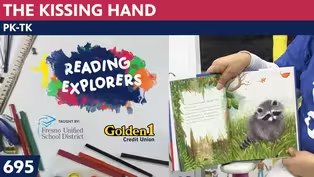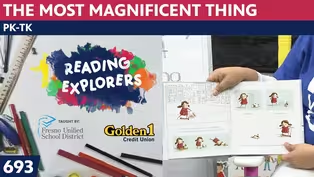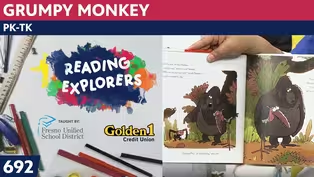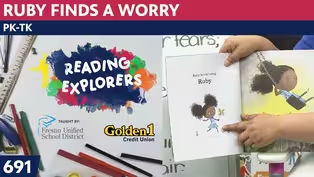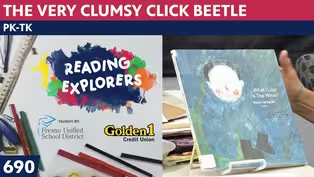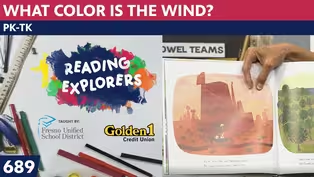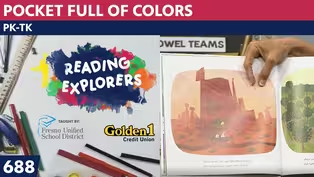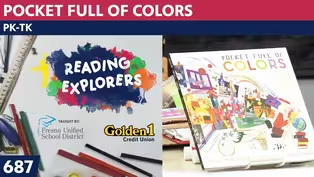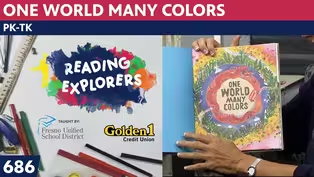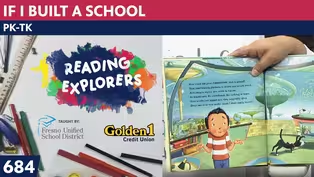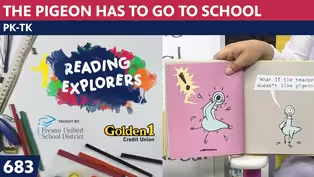
TK-365: Wassily Kandinsky’s “Several Circles”
Season 3 Episode 361 | 14m 14sVideo has Closed Captions
Join Mrs. Readwright at Camp Discovery!
Join me today as we finish our Earth Day celebration week. Each day we will introduce masterpieces that illustrate a part of our beautiful planet Earth . We will finish our earth project. We will create outer space. Today we look at Kandinsky’s “Several Circles” (which look like planets) If you would like to make artwork that shows outer space like Kandinsky's, bring our circle project.
Problems playing video? | Closed Captioning Feedback
Problems playing video? | Closed Captioning Feedback
Reading Explorers is a local public television program presented by Valley PBS

TK-365: Wassily Kandinsky’s “Several Circles”
Season 3 Episode 361 | 14m 14sVideo has Closed Captions
Join me today as we finish our Earth Day celebration week. Each day we will introduce masterpieces that illustrate a part of our beautiful planet Earth . We will finish our earth project. We will create outer space. Today we look at Kandinsky’s “Several Circles” (which look like planets) If you would like to make artwork that shows outer space like Kandinsky's, bring our circle project.
Problems playing video? | Closed Captioning Feedback
How to Watch Reading Explorers
Reading Explorers is available to stream on pbs.org and the free PBS App, available on iPhone, Apple TV, Android TV, Android smartphones, Amazon Fire TV, Amazon Fire Tablet, Roku, Samsung Smart TV, and Vizio.
Providing Support for PBS.org
Learn Moreabout PBS online sponsorshipMore from This Collection
Valley PBS and Fresno Unified School District have partnered with Golden 1 Credit Union to create Reading Explorers Lessons for grades Pre-Kindergarten through Third grade. The daily lessons will be taught by Fresno Unified School District teachers and are created to help students practice their reading skills and reinforce lessons during distance learning.
Video has Closed Captions
Valley PBS presents Reading Explorers Lessons for Pre-Kindergarten and TK. (26m 27s)
PK-TK-693-The Most Magnificent Thing
Video has Closed Captions
Valley PBS presents Reading Explorers Lessons for Pre-Kindergarten and TK. (26m 26s)
Video has Closed Captions
Valley PBS presents Reading Explorers Lessons for Pre-Kindergarten and TK. (26m 28s)
Video has Closed Captions
Valley PBS presents Reading Explorers Lessons for Pre-Kindergarten and TK. (26m 28s)
PK-TK-690: The Very Clumsy Click Beetle
Video has Closed Captions
Valley PBS presents Reading Explorers Lessons for Pre-Kindergarten and TK. (26m 22s)
PK-TK-689: What Color is the Wind?
Video has Closed Captions
Valley PBS presents Reading Explorers Lessons for Pre-Kindergarten and TK. (26m 21s)
PK-TK-688: Pocket Full of Colors
Video has Closed Captions
Valley PBS presents Reading Explorers Lessons for Pre-Kindergarten and TK. (25m 58s)
PK-TK-687: Dancing Through Fields of Colors
Video has Closed Captions
Valley PBS presents Reading Explorers Lessons for Pre-Kindergarten and TK. (26m 20s)
PK-TK-686: One World Many Colors
Video has Closed Captions
Valley PBS presents Reading Explorers Lessons for Pre-Kindergarten and TK. (27m 13s)
PK-TK-685: School is Wherever I am
Video has Closed Captions
Valley PBS presents Reading Explorers Lessons for Pre-Kindergarten and TK. (26m 32s)
PK-TK-684: If I Built a School
Video has Closed Captions
Valley PBS presents Reading Explorers Lessons for Pre-Kindergarten and TK. (26m 21s)
PK-TK-683: The Pigeon Has to Go to School
Video has Closed Captions
Valley PBS presents Reading Explorers Lessons for Pre-Kindergarten and TK. (26m 22s)
Providing Support for PBS.org
Learn Moreabout PBS online sponsorship(cheerful Music) ♪ Good morning to a brand new day ♪ ♪ Time to learn and the games to play ♪ ♪ Learning things is so much fun ♪ ♪ Learning is good for everyone ♪ (playful music) - Hello, early learners.
Welcome back to the art room.
It is I, Mrs. Readwright.
I'm happy to have everyone back on our Friday of Earth Week.
We're talking about Earth Week because yesterday was Earth Day, where we think about our planet and try to make plans of how we can help our planet be a beautiful place for the rest of our lives and the lives of others that come to live after we are here.
So yesterday we did a model of the earth using a photograph that NASA had taken.
But today we're going back to our project that we started on Monday, and we did the "I Love the Mountains" song.
So I thought we could start our boom-de-yah-da today.
And we start.
♪ Boom-de-yah-da, boom-de-yah-da ♪ ♪ Boom-de-yah-da, boom-de-yah-da ♪ ♪ I love the mountains ♪ ♪ I love the rolling hills ♪ ♪ I love the flowers ♪ ♪ I love the daffodils ♪ ♪ I love the fireside when all the lights are low ♪ ♪ Boom-de-yah-da, boom-de-yah-da ♪ ♪ Boom-de-yah-da, boom-de-yah-da ♪ All right, when I think about the art that we did, I thought maybe below my trees I could put some flowers, because those are on the earth.
I could make some birds in the trees.
I can add things to my painting however I would like.
And the same goes for you.
Now, today, who we are going to bring into the picture is Wassily, or Wassily, they say, Wassily Kandinsky.
And Wassily Kandinsky is one that when you were in pre-K, if you're in Fresno schools, you knew about his concentric circles and squares.
And it's where the dots study came from, where the dots are inside the squares.
And the dot is inside the squares, and it gets smaller, smaller, smaller, or bigger, bigger, bigger.
Concentric is inside one another till it gets down to just a dot.
So what he did, when Kandinsky started being an artist, he thought everything had to look like a landscape.
So he thought everything was realistic.
Well, then he found out when he did a subject where it was just a shape repeated over and over again, he could focus more on color than on what he would do in the past.
Now he could just talk about his art and think about just one shape.
So when we look at this art print by Kandinsky, you'll see it's all circles, but you'll see the rich colors he chose.
And I thought those circles looked a lot like planets.
And I thought it would be fun to do some planets out in space.
They don't have to be in the order like we learned in science.
I'm going to make a sun, but the sun doesn't really have little rays like I like to draw.
Rather, it's a big ball of fire.
But what Kandinsky is doing and we're going to look at is abstract.
It doesn't have a topic or a subject.
It's just the circles, and he even named it "Several Circles."
So let's take a look at it.
Let me move my song out of the way.
All righty, and I'm turning.
When we looked at another picture of Kandinsky.
He was kind of the same way with his glasses on and he looks kind of serious.
And look, when they say his name, they say the V in front, but really it's a W that's printed there, but it says Wassily Kandinsky.
And this is the picture that we're looking at today.
Look how some of the circles are out in space.
Some are circles, some are dots.
You know the difference between a circle and a dot?
The circle is the outline, the dot is it filled in.
So you can see this one kind of looks like a planet, and then here might be their moons.
So we're going to do some things like this.
And I liked that the background was dark and black like space is on our other pictures.
Although the child who did this one that we've been using as our inspiration and model, they used a darker blue in the background.
I think they did that so you could see the spirals.
I think they like spirals as much as I do.
Does anyone know what this planet is called?
It's a planet that's in our solar system.
It has a ring around it.
Is that a ring?
It's lots of little particles.
It makes it look like a ring, but they're just flying around and around.
Look at this shape; it's a crescent.
When people ask you what shape is that?
A lot of times, in the old days, people said, "Oh, it's a moon," but we know the moon is a crescent shape sometimes.
Sometimes it's full, but this one is a crescent.
And then they drew some stars.
Let's see how many points.
It's one, two, three, four, a five point star.
And when I teach children to do this, I say make it like a capital A whose arms are stretched out and then touch the toes.
And I'll help you do that if you want to put some stars on yours.
So let's get up our table and get started on our space part of our art.
Move this over, move all my paints down here so I can reach them and put my table up.
You can see I painted in some more of my ocean and my river.
And here I put the sky in.
So let me move this around.
I'm gonna get my inspiration piece, the small one up here.
They put their sun in this corner.
Maybe I'll put mine in there too.
And then I'll start thinking about Kandinsky's circles and just put them around places, and maybe some stars.
I'd like to show you how to make the star.
Now the bad thing about it is, since I didn't bring a pencil to do it, 'cause I don't think you can see it, I'm going to show you how I do it.
So with a black pen, and it won't fill in like I'd like.
But first you do like a capital A.
First the standing line.
Then the arms go across, stretch them all the way out.
And then you have it touch its toe on that side, and take this hand, and touch its toe on this side.
So there's one star.
I'll put another one down here.
There is the tipi tent shape.
I put the arms of the capital A out too far.
You don't want to do it like that if you're writing the letter, but to make a star, you do, and touch your toe on that side.
Take this far hand and go to this toe.
There we go.
All right, now I'm gonna use a big black pen to do my sun and have it be all the way down.
I'm not going to make a circle here.
I'm gonna do it like they did, how they made theirs just start off the edge of the paper.
And I'm going to do kind of a fiery shape Kind of how Klimt might've done it with his, remember his "Tree of Life" and all of those spirally pieces?
And just off to the edge.
I like the way that looks.
And you know I want to do a few spirals.
And I do my spiral around, and I do my spirals around.
I don't have to do them all over, but I like the look of it some places.
And I'm gonna do some dot planets down here.
Small planet.
I could overlap some.
I think that might look good in some places.
I'm just gonna put some celestial bodies.
That just means things that are out in space.
I'm going to do an overlap here and see what happens when I mix the colors.
And I'll do another one right here.
Here, and a couple more.
I liked the idea of the Saturn, but the Saturn is going to need its ring drawn first.
And then I'll make the come around.
Ooh, I made it like an oval, how funny.
It still looks okay to me.
Maybe I'll put the moon down here with the stars, make it come in like they did.
I'll do off the edge, and make the crescent.
Oh, it'll just go off.
It'll make it big.
I think I want to make that be dark right now so that I'll remember about.
Hey, don't you fall, you paintbrush.
I'm gonna use my wash brush and get into this black as night and go near the moon.
Let's see what it looks like.
Oh yeah, I'm going near the edge and pulling it.
I'll get a little more water.
I'll go near the edge and pull it.
This is the advantage to painting on a tabletop rather than an easel or something.
That's why, boys and girls, I do it on my lap because then my paints don't run down.
And if I want it to look more like a bluish night sky, I can go back over it with the blue paint.
Started out with my black and filled in with my blue.
And I go near the edge of the thing that I'm painting and pull out.
I go near the edge of the thing I'm painting and pull out.
That way I don't mix it up with my star.
And I keep the drips from happening.
So I just dip in, get my paint, put it near the edge, and pull out.
I put it near the edge of the line that I drew and pull it out.
I put it near the edge of my line and pull out.
I put it in near the edge of my line.
And can I hear you say it?
Pull out.
Everyone's saying, "Put it on the edge of my line and pull out."
I even talk to myself when I'm painting so I remember to do the directions that I know will make my art look great.
So now I have a bunch of different little brush marks.
And if I go back in with my blue, it will look great.
I'll go over it with my blue and mix it in and make the brush strokes be a little more contained and back to their right shape.
Now the same thing, I get near the earth.
I will put on the edge and pull it out there.
On the edge, and pull it out that way.
Pull it out.
Are you trying it this way?
Or do you have your own system?
If you try it my way, and you think, "Oh, that doesn't work for me," don't do it.
It's just what I've learned as I've gotten from being just a girl to being a woman.
I think, "Oh, I could try this."
And I find, "I'll tell kids that."
Because if I tell you what worked for me, you think, "Oh, then you're saving us from making the mistake."
My paper's starting to get a little wet, and it bubbles up like this.
So at night, what I do with my art, I put books on top of it.
I put a piece of newspaper on top so any paint that might still be there, it won't get on to the book.
Because you don't want to just put a book on top of your wet painting.
That is not a good idea.
Because what happens then is it will get the paint on the cover of your book.
And someone will say, "Hey, who's been painting near our good books?"
And you think, "Oh, that was me."
And you say, "I did it, but I won't do it next time."
I learned that the paint gets on to anything you set on top, and we don't want that to happen.
'Cause you know I tell you all the time.
If you make a mess with art, that's when parents say, "We don't do art at our house."
Because they say it's too messy.
And we don't want them to say that.
We want them to say, "Oh, isn't art the best thing?"
Boy, it's gonna take me a long time to do this.
I think I want to put some of the red and orange sun and show you how I like to mix my colors for that.
Let me get a different brush that hasn't been in that black water.
Old black water.
Don't do 'em on there.
And I will bring this over.
Is it stuck to that one?
It still has all the paints from before.
I have a red and an orange I can put in here.
So I'll put the red as the tip and fiery part.
Boys and girls, this has been a great week together.
It's almost time to say goodbye.
So remember, next week, we're going to be talking about Monet and his water lilies.
So if you look at it over the weekend and think about what you will be doing with it with me next week, it will be great.
I'm gonna finish up a little bit more of my sun.
I hope that you will take pictures of yourself working.
Maybe you'll send me pictures.
And if you do and send your home address here, we'll send you one of our activity books.
Boys and girls, thanks for joining me.
I'll see you next week.
Happy weekend.
(cheerful music) ♪ Good morning to a brand new day ♪ ♪ Time to learn and games to play ♪ ♪ Learning things is so much fun ♪ ♪ Learning is good for everyone ♪
Support for PBS provided by:
Reading Explorers is a local public television program presented by Valley PBS
